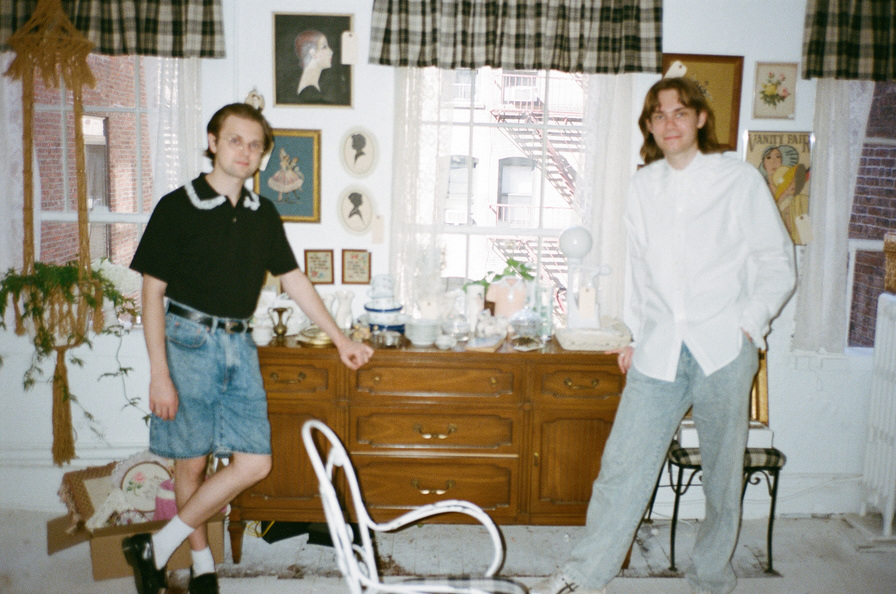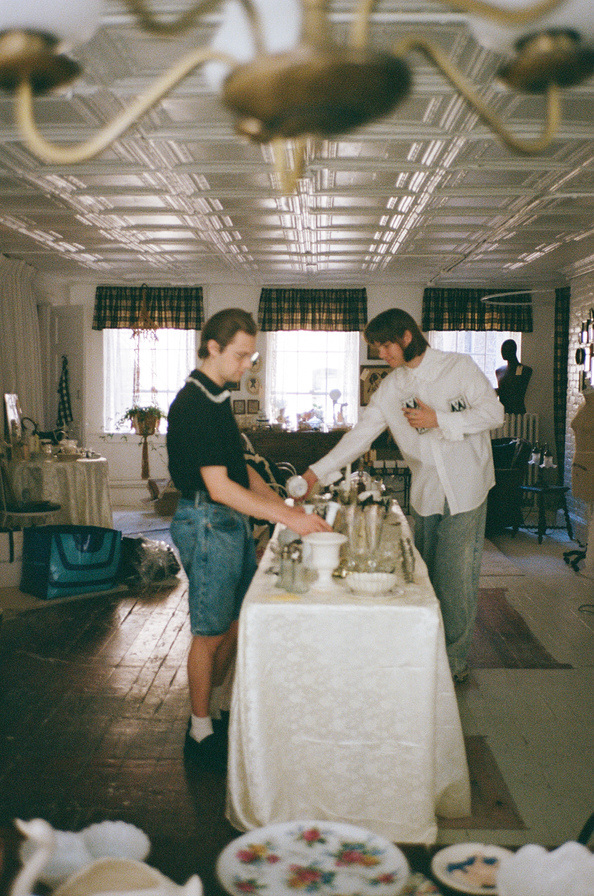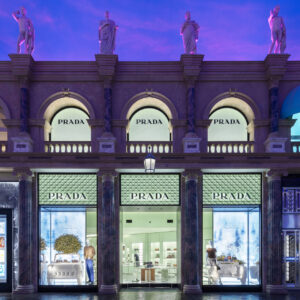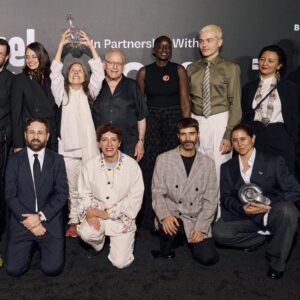
I met Tanner Richie and Fletcher Kasell during a recent dinner at the new Quarters concept store in Tribeca, and we immediately hit it off. The duo first chanced upon one another during their college roommate search at the University of Minnesota, quickly became a couple, then moved to New York and founded their genderless clothing brand Tanner Fletcher during the pandemic. Focused on “fluid luxury,” they set out to challenge outdated views in the fashion industry, which we discussed in detail when we reconnected—along with drawing inspiration from vintage interiors and the English countryside, the influence of the coquette movement on our wardrobes and homes, and how they see themselves as the “Gen-Z Martha Stewart.”

What’s the story behind Tanner Fletcher? How did you first start out?
Tanner Richie: We were at the University of Minnesota for a year and a half, then we interned in New York. I was at Schumacher fabrics, and Fletcher was at Zero Maria Cornejo, and we ended up falling in love with the city. So we stopped school, moved here, and continued interning. Then we started our brand during the pandemic. We were still in school—we were finishing at LIM College online—and we started with small tote bags and T-shirts.
Fletcher Kasell: It was more of a hobby, but when small boutiques started picking up those little tote bags, we thought, Wow, maybe we could actually do something with this. We were a little bit nervous, because we weren’t trained at all, and we’d have to really throw ourselves into it. But we did it, and now we’re here!
I’m self-taught too, and I think sometimes that lack of experience can become your secret power. Can you pinpoint your big break?
Richie: Our first collection was Spring/Summer 2022. We were picked up by Ssense that season, and that’s when people started taking us more seriously. Becoming 2023 CFDA/Vogue Fashion Fund finalists helped a lot too. Before that, Bad Bunny wore our Bow Blazer for Time magazine, and that really put us on the map. In fashion, there’s so much validation needed, and that was a really big step for us.

Your Instagram bio describes your brand as “fluid luxury.” Can you explain what that means to you?
Kasell: One of the main reasons we wanted to start the brand was to remove gender labels. Both of us have a little bit of feminine flair, and we noticed that when we would go shopping at department stores, the sales associates would immediately look at us and say, “Oh, the men’s section is over there.” The more that happens, the more it gets to you, and it feels like, “I’m not allowed to wear that because somebody’s directing me elsewhere, even though it’s my taste, it’s my style, and I’m really gravitating towards it.” So we wanted to remove this invisible barrier when it comes to shopping for clothes. That’s why we call it fluid luxury, because there’s really no label or box for our customers to fit in.
With more eyes on your brand, more opinions begin to appear. Have you experienced any backlash against your designs and ideals?
Richie: Honestly, we’ve been really supported. Occasionally there’s a couple of Internet trolls, but we put out a pretty positive vibe, so it’s a little hard to hate on it. More traditional department stores have a harder time grasping the genderless concept, or ask “Where do we put it?” And we’re like, “You put it wherever you think it will sell.” There’s a lot of outdated mindsets that still exist in the fashion industry that we’re slowly moving away from, but there are still people who have been in the same positions for a long time, and frankly need to be replaced by a newer mindset. When that happens, that’s when our floodgates are going to open.
Kasell: Some of these people have been doing the same thing for decades. And similar to how I can’t see why they want to label genders, they can’t see why we want to remove them. So that’s really the only barrier that we’re facing.

What are some of the common themes, silhouettes, or materials found across your designs? And what do they represent?
Richie: Ruffles, lace, bows, white cotton poplin, black and white and ivory, and denim. That’s really the base.
Kasell: The core of our brand is actually really classic, but with a little touch of ornamentation. It’s sometimes hard to tell, but we get a lot of that inspiration from interiors, like the ruffles. We start by looking at images of vintage interiors. Right now we’re really into the 1940s, and that era is just covered in ruffles and ornamentation. Whoever’s house it is, they took the time to sew on every piece of trim and every little bow onto even the curtain under their sink. That’s where we look for those fine details and bring it into the clothes.
Richie: English design is really important to the brand too. The countryside and London are a big inspiration, especially the colors. You’ll never see us do neon or a really bold color. Everything is quite muted. We did do red for our last collection, but it’s not in-your-face red. We try to keep the colors pretty light and airy.
Kasell: I always describe the way we design a collection as how you would seasonally decorate a room for the holidays. You leave the base of the room, it doesn’t really change. Then you add and layer in the throw pillows, change the tablecloths, change the floral arrangements.
Richie: That’s where the color comes in. It’s never too color-heavy, the base of the collection will always read very neutral. The pops of colors are really intentional.

You recently launched a wedding collection. Tell me more about that.
Richie: We’ve had customers that would shop our ready-to-wear for their weddings, and we’d see pictures of them. So we saw an opportunity here to grow this category. We have some friends who are in the wedding apparel space, and they told us to just do it because that industry is so outdated. So we did, and it’s been really successful.
Kasell: When we researched the wedding industry, we noticed that it was really traditional. It’s the same “optic white” uniform. There’s really no attention paid to the grooms at all, and there’s really nothing for queer people of any kind. We already had this niche market looking at us for weddings, so it was really rewarding to see and meet all these people.
Richie: And to provide something for our community, the queer community, that is more inspiring to see. If I was getting married and I didn’t have the brand, I would have no idea where to go. Men’s Wearhouse?! What do you do?
Kasell: Especially when your gender fluctuates on a spectrum. If you’re a more feminine guy, where are you going to go to find that outfit for your wedding? You don’t want to be given side-eye when you walk in the door of a boutique. It’s all about the experience. And the same thing for women, where are they going to buy suits? Sure, some of the wedding designers have a “mother of the bride” suit, but they don’t want that, and they don’t want to have dresses shoved down their throats either. Again, we create a label-free environment.

There’s been a notable return to romanticism in the design world recently. Why do you think that is?
Richie: The “coquette” movement, if you can call it that, has really played a role in this. It’s coming from celebrities that dress that way, like Lana Del Rey, who’s pushed the coquette, romantic style—probably without even knowing it, or intending to. But when someone becomes very well known to the public, like she has, people pick up on those things. The more people like her that are dressing that way, and living that lifestyle, it keeps funneling down to the masses.
Kasell: I don’t know if it’s the economy, but I feel like we went through the period of “millennial gray”, and really stark design across fashion and interiors. The way people lived was very minimal. Now all of a sudden, we’re shifting back to people designing their own interiors, staining their own cabinets, making their own curtains, and picking out the materials. It’s more intentional. Younger people right now want to have a part in the creative direction of their own style.
Richie: They don’t want to be like everyone else. They want their space to be really unique. And we’re finding that with dressing as well. Self-expression is really coming back strong. I’ve found that a lot of people’s dressing matches their interior aesthetic. Nobody talks about that enough. We’re really trying to bridge the two worlds together because they’re so connected.
Kasell: Something we want to do in the future is to produce our own patterns and sell them to our customers, because people want to sew their own dresses and craft their own things.
Richie: We’re like the Gen-Z Martha Stewart, if you will. We’ll tell you how to make a gallery wall and also sell you a dress. A little bit of everything.

What’s next for the two of you?
Kasell: I feel like “what’s next” is happening right now. We just moved into our first studio space, which is a really big deal for us and for the brand. It’s already helped the business so much. In the long run, the next step would be thinking about a store or a physical space. Or even in between, before we have the store, how are we showing up in person and creating a community?
Richie: We’ve been talking about doing a pop-up shop during fashion week, in Soho or the Lower East Side, somewhere we can actually engage with the customers. We’re finding that’s one of our favorite parts of having the brand. We’re trying to be open to different ways of doing things. The fashion industry is quite flawed in the way of what’s expected of you as designers, and I think those expectations are changing, because a lot of brands can’t really keep up with the old guard. We’re really focusing now on what works for us. When we first started, we thought, We have to do what everyone else is doing, because if we want to work in fashion, that’s the system. We’re very quickly realizing that some of those things can be almost the death of a brand.










 in your life?
in your life?

